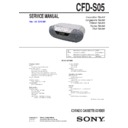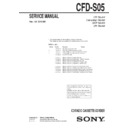Read Sony CFD-S05 (serv.man2) Service Manual online
SERVICE MANUAL
Sony Corporation
Audio&Video Business Group
Published by Sony Techno Create Corporation
CFD-S05
SPECIFICATIONS
CD RADIO CASSETTE-CORDER
9-889-821-01
2010C04-1
©
2010.03
Australian Model
Singapore Model
Taiwan Model
Korea Model
Thai Model
Ver. 1.0 2010.03
CD player section
System
System
Compact disc digital audio system
Laser diode properties
Emission duration: Continuous
Laser output: Less than 44.6
μW
(This output is the value measured at a distance of
about 200 mm from the objective lens surface on the
optical pick-up block with 7 mm aperture.)
Number of channels
2
Frequency response
20 Hz - 20,000 Hz +1/–2 dB
Wow and fl utter
Below measurable limit
Radio section
Frequency range
Frequency range
FM: 87.5 MHz - 108 MHz
Except SP model:
AM: 531 kHz - 1,602 kHz
SP
model:
AM: 531 kHz - 1,602 kHz (9 kHz step)
530 kHz - 1,610 kHz (10 kHz step)
CD
Section
Section
Model Name Using Similar Mechanism
NEW
Optical Pick-up Name
DA11MMVGP
TC
Section
Section
Model Name Using Similar Mechanism
NEW
Tape Transport Mechanism Type
MF-S05V
IF (AUS, TH model)
FM: 128 kHz
AM: 45 kHz
Antennas
FM:
FM:
Telescopic
antenna
AM: Built-in ferrite bar antenna
Cassette-corder section
Recording system
Recording system
4-track 2 channel stereo
Fast winding time
Approx. 150 s (sec.) with Sony cassette C-60
Frequency response
TYPE I (normal): 80 Hz - 10,000 Hz
General
Speaker
Speaker
Full range: 8 cm dia., 4
Ω, cone type (2)
Outputs
Headphones jack (stereo minijack):
For
16
Ω - 32 Ω impedance headphones
Input
AUDIO IN jack (stereo minijack)
– Continued on next page –
CFD-S05
2
NOTES ON CHIP COMPONENT REPLACEMENT
• Never reuse a disconnected chip component.
• Notice that the minus side of a tantalum capacitor may be dam-
• Never reuse a disconnected chip component.
• Notice that the minus side of a tantalum capacitor may be dam-
aged by heat.
FLEXIBLE CIRCUIT BOARD REPAIRING
• Keep the temperature of soldering iron around 270 °C during
• Keep the temperature of soldering iron around 270 °C during
repairing.
• Do not touch the soldering iron on the same conductor of the
circuit board (within 3 times).
• Be careful not to apply force on the conductor when soldering
or unsoldering.
SAFETY-RELATED COMPONENT WARNING!
COMPONENTS IDENTIFIED BY MARK 0 OR DOTTED LINE
WITH MARK 0 ON THE SCHEMATIC DIAGRAMS AND IN
THE PARTS LIST ARE CRITICAL TO SAFE OPERATION.
REPLACE THESE COMPONENTS WITH SONY PARTS
WITH MARK 0 ON THE SCHEMATIC DIAGRAMS AND IN
THE PARTS LIST ARE CRITICAL TO SAFE OPERATION.
REPLACE THESE COMPONENTS WITH SONY PARTS
WHOSE PART NUMBERS APPEAR AS SHOWN IN THIS
MANUAL OR IN SUPPLEMENTS PUBLISHED BY SONY.
MANUAL OR IN SUPPLEMENTS PUBLISHED BY SONY.
CAUTION
Use of controls or adjustments or performance of procedures
other than those specifi ed herein may result in hazardous radia-
tion exposure.
Use of controls or adjustments or performance of procedures
other than those specifi ed herein may result in hazardous radia-
tion exposure.
NOTES ON HANDLING THE OPTICAL PICK-UP
BLOCK OR BASE UNIT
BLOCK OR BASE UNIT
The laser diode in the optical pick-up block may suffer electro-
static break-down because of the potential difference generated by
the charged electrostatic load, etc. on clothing and the human body.
During repair, pay attention to electrostatic break-down and also
use the procedure in the printed matter which is included in the
repair parts.
The fl exible board is easily damaged and should be handled with
care.
static break-down because of the potential difference generated by
the charged electrostatic load, etc. on clothing and the human body.
During repair, pay attention to electrostatic break-down and also
use the procedure in the printed matter which is included in the
repair parts.
The fl exible board is easily damaged and should be handled with
care.
NOTES ON LASER DIODE EMISSION CHECK
The laser beam on this model is concentrated so as to be focused
on the disc refl ective surface by the objective lens in the optical
pickup block. Therefore, when checking the laser diode emission,
observe from more than 30 cm away from the objective lens.
The laser beam on this model is concentrated so as to be focused
on the disc refl ective surface by the objective lens in the optical
pickup block. Therefore, when checking the laser diode emission,
observe from more than 30 cm away from the objective lens.
NOTES ON DUALDISCS
A DualDisc is a two sided disc product which mates DVD record-
ed material on one side with digital audio material on the other
side. However, since the audio material side does not conform to
the Compact Disc (CD) standard, playback on this product is not
guaranteed.
A DualDisc is a two sided disc product which mates DVD record-
ed material on one side with digital audio material on the other
side. However, since the audio material side does not conform to
the Compact Disc (CD) standard, playback on this product is not
guaranteed.
Power output
1.7 W + 1.7 W (at 4
Ω, 10% harmonic distortion)
Power requirements
For CD radio cassette-corder:
120 V AC, 60 Hz (TW model)
230 V AC, 50 Hz (AUS model)
220 V AC, 50 Hz (TH model)
220 V AC, 60 Hz (KR model)
230 V AC - 240 V AC, 50 Hz (SP model)
9 V DC, 6 R14 (size C) batteries
Power consumption
AC
AC
13
W
Battery life
For CD radio cassette-corder:
FM recording
Sony R14P: approx. 4.5 h
Sony alkaline LR14: approx. 19 h
Tape playback
Sony R14P: approx. 2.5 h
Sony alkaline LR14: approx. 13 h
CD playback
Sony R14P: approx. 1 h
Sony alkaline LR14: approx. 8 h
FM recording
Sony R14P: approx. 4.5 h
Sony alkaline LR14: approx. 19 h
Tape playback
Sony R14P: approx. 2.5 h
Sony alkaline LR14: approx. 13 h
CD playback
Sony R14P: approx. 1 h
Sony alkaline LR14: approx. 8 h
Dimensions
Approx. 365 mm
× 134 mm × 230 mm (w/h/d)
(incl. projecting parts)
Mass
Approx. 2.7 kg (incl. batteries)
Supplied accessory
AC power cord (1)
Design and specifi cations are subject to change
without notice.
without notice.
• Abbreviation
AUS :
AUS :
Australian
model
KR
: Korean model
SP
: Singapore model
TH :
Thai
model
TW :
Taiwan
model
CFD-S05
3
1.
SERVICING NOTES
............................................. 4
2. DISASSEMBLY
2-1. Cabinet (Upper) Section ................................................. 6
2-2. Cabinet (Front) Section ................................................... 6
2-3. MAIN Board ................................................................... 7
2-4. POWER
2-2. Cabinet (Front) Section ................................................... 6
2-3. MAIN Board ................................................................... 7
2-4. POWER
Board
................................................................ 7
2-5. CD
Block
Assy
................................................................ 8
2-6. MOTOR
Board
............................................................... 8
2-7. CD
Lid
............................................................................ 9
2-8. MD
Block
Assy
............................................................... 9
2-9. Cassette
Lid
..................................................................... 10
2-10. KEY Board ...................................................................... 10
3. MECHANICAL
ADJUSTMENTS
...................... 11
4. ELECTRICAL
ADJUSTMENTS
Tape Section .................................................................... 11
Tuner
Section
..................................................................
12
CD
Section
......................................................................
13
5. DIAGRAMS
5-1. Block Diagram –CD Section– ........................................ 15
5-2. Block Diagram –Main Section– ..................................... 16
5-3. Printed Wiring Board –Main Section– ............................ 18
5-4. Printed Wiring Boards –Key, Power Section– ................ 19
5-5. Schematic Diagram –Main Section (1/3)– ...................... 20
5-6. Schematic Diagram –Main Section (2/3)– ...................... 21
5-7. Schematic Diagram –Main Section (3/3)– ...................... 22
5-8. Schematic Diagram –Key Section– ................................ 23
5-9. Schematic Diagram –Power Section– ............................. 24
5-2. Block Diagram –Main Section– ..................................... 16
5-3. Printed Wiring Board –Main Section– ............................ 18
5-4. Printed Wiring Boards –Key, Power Section– ................ 19
5-5. Schematic Diagram –Main Section (1/3)– ...................... 20
5-6. Schematic Diagram –Main Section (2/3)– ...................... 21
5-7. Schematic Diagram –Main Section (3/3)– ...................... 22
5-8. Schematic Diagram –Key Section– ................................ 23
5-9. Schematic Diagram –Power Section– ............................. 24
6.
EXPLODED VIEWS
6-1. Overall
Section
............................................................... 30
6-2. Cabinet (Front) Section ................................................... 31
6-3. Cabinet (Upper) Section (1) ............................................ 32
6-4. Cabinet (Upper) Section (2) ............................................ 33
6-5. Cabinet (Rear) Section .................................................... 34
6-3. Cabinet (Upper) Section (1) ............................................ 32
6-4. Cabinet (Upper) Section (2) ............................................ 33
6-5. Cabinet (Rear) Section .................................................... 34
7.
ELECTRICAL PARTS LIST
.............................. 35
TABLE OF CONTENTS
UNLEADED SOLDER
Boards requiring use of unleaded solder are printed with the lead-
free mark (LF) indicating the solder contains no lead.
(Caution: Some printed circuit boards may not come printed with
Boards requiring use of unleaded solder are printed with the lead-
free mark (LF) indicating the solder contains no lead.
(Caution: Some printed circuit boards may not come printed with
the lead free mark due to their particular size)
: LEAD FREE MARK
Unleaded solder has the following characteristics.
• Unleaded solder melts at a temperature about 40 °C higher
• Unleaded solder melts at a temperature about 40 °C higher
than ordinary solder.
Ordinary soldering irons can be used but the iron tip has to be
applied to the solder joint for a slightly longer time.
applied to the solder joint for a slightly longer time.
Soldering irons using a temperature regulator should be set to
about 350 °C.
Caution: The printed pattern (copper foil) may peel away if
about 350 °C.
Caution: The printed pattern (copper foil) may peel away if
the heated tip is applied for too long, so be careful!
• Strong
viscosity
Unleaded solder is more viscous (sticky, less prone to fl ow)
than ordinary solder so use caution not to let solder bridges
occur such as on IC pins, etc.
than ordinary solder so use caution not to let solder bridges
occur such as on IC pins, etc.
• Usable with ordinary solder
It is best to use only unleaded solder but unleaded solder may
also be added to ordinary solder.
also be added to ordinary solder.
CFD-S05
4
SECTION 1
SERVICING NOTES
CHUCK PLATE JIG ON REPAIRING
On repairing CD section, playing a disc without the lid (CD), use
Chuck Plate Jig.
• Code number of Chuck Plate Jig: X-4918-255-1
Chuck Plate Jig.
• Code number of Chuck Plate Jig: X-4918-255-1
LASER DIODE AND FOCUS SEARCH OPERATION
CHECK
1. Turn ON the [OPERATE] button and press [CD] button to CD
CHECK
1. Turn ON the [OPERATE] button and press [CD] button to CD
position.
2. Open the CD lid.
3. Turn on S801 with screwdriver, etc. as following fi gure.
4. Press the [
3. Turn on S801 with screwdriver, etc. as following fi gure.
4. Press the [
N
X
] (CD) button.
5. Confi rm the laser diode emission while observing the object-
ing lens. When there is no emission, Auto Power Control cir-
cuit or Optical Pick-up is broken.
cuit or Optical Pick-up is broken.
Objective lens moves up and down three times for focus
search.
S801
PRECAUTION WHEN INSTALLING A NEW OP UNIT/
PRECAUTION BEFORE UNSOLDERING THE STATIC
ELECTRICITY PREVENTION SOLDER BRIDGE
PRECAUTION BEFORE UNSOLDERING THE STATIC
ELECTRICITY PREVENTION SOLDER BRIDGE
When installing a new OP unit, be sure to connect the fl exible
printed circuit board fi rst of all before removing the static electric-
ity prevention solder bridge by unsoldering.
Remove the static electricity prevention solder bridge by unsolder-
ing after the fl exible printed circuit board has already been con-
nected.
(Do not remove nor unsolder the solder bridge as long as the OP
unit is kept standalone.)
printed circuit board fi rst of all before removing the static electric-
ity prevention solder bridge by unsoldering.
Remove the static electricity prevention solder bridge by unsolder-
ing after the fl exible printed circuit board has already been con-
nected.
(Do not remove nor unsolder the solder bridge as long as the OP
unit is kept standalone.)


